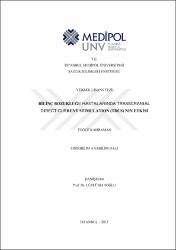Bilinç bozukluğu hastalarında transcranial direct current stimulation (TDCS) nın etkisi
Künye
Kahraman, T. (2017). Bilinç bozukluğu hastalarında transcranial direct current stimulation (TDCS) nın etkisi. (Yayınlanmamış yüksek lisans tezi). İstanbul Medipol Üniversitesi Sağlık Bilimleri Enstitüsü, İstanbul.Özet
Kronik bilinç bozuklukları (KBB) hasta bakımının aile ve sağlık sistemine getirdiği yük ve toplum sağlığı açısından ciddi etkileri olan bir durumdur. Son yıllarda transcranial direct current stimulation (tDCS) tekniği bu alanda önerilmiş ve umut verici az sayıda çalışma bildirilmiştir. Ancak nörofizyolojik ve nörogörüntüleme yöntemleri ile desteklenen çalışma sayısı kısıtlıdır. Bu durum hem düzelmeyi objektif kriterler çerçevesinde gösterebilmek hem de altta yatan fizyopatolojik mekanizmaların anlaşılması bakımından güçlük oluşturmaktadır. Bu çalışmada tDCS'nin kronik bilinç bozukluğuna etkisininin klinik, QEEG ve fMRG ile değerlendirilmesi amaçlanmıştır. Çalışmaya Medipol Mega Hastaneleri Yoğun Bakım Ünitesinde yatmakta olan hipoksik ensefelopati tanılı 9 hasta dahil edilmiştir.10 seans sol anodal dorsolateral prefrontal korteks (DLPFC) üzerine 20 dakika, 2mA tDCS uygulaması öncesi ve sonrası spontan EEG çekilmiş olup , dinlenim durumu fMRG uygulanmıştır. Analizde ise güç spektrumlarına bakılmış, klinik durumu JFK koma iyileşme skalası- revize edilmiş (CRS-R) ile değerlendirilmiştir. Güç spektrumunda; Delta (1-3.5 Hz), teta (4-8 Hz), alfa (8-13 Hz), beta (15-30 Hz), frekans aralıklarına bakılmıştır. Sonuçta tDCS uygulama sonrası genel olarak ölçülen tüm frekanslarda alfa ve beta yoğunluklu genel bir artış bulunurken, delta ve teta aktivitesi ile jfk koma skalası görsel ve işitsel alt skalalarda frontal başta olmak üzere tüm lokasyonlarda anlamlı korelasyon bulunmuştur. fMRG değerlerinde ise anlamlı bir fark bulunamamıştır. Chronic disorder of consciousness (DOC) is a condition that seriously impacts in terms of the burden of care on family and community health and health systems. In recent years transcranial direct current stimulation (tDCS) technique has been proposed in this area and few promising studies have been reported. However, the number of studies supported by neurophysiological and neuroimaging methods are limited. This situation is both difficult to objectively demonstrate healing and difficult to understand the underlying physiopathological mechanisms. In this study to evaluate the effect of tDCS in chronic impairment of consciousness by means of QEEG and fMRI. Nine patients with hypoxic encephalopathy who were hospitalized at the Medipol Mega Hospitals Intensive Care Unit were included in the study. Spontaneous EEG was taken for 10 minutes and rest state fMRG was applied before and after 2mA tDCS application on the left anodal dorsolateral prefrontal cortex (DLPFC) for 20 minutes. In the analysis, the power spectrum was considered and the clinical status was assessed with the JFK coma recovery scale (CRS-R). In the power spectrum; Delta (1- 3.5 Hz), theta (4-8 Hz), alpha (8-13 Hz) and beta (15-30 Hz) frequency ranges are examined. After tDCS application in all of the measured frequencies are increased in general, particularly alpha and beta. Correlation in all locations with JFK visual and audio subscale -especially frontal- was found in delta and theta activity. There was no significant differences in fMRG values.
Koleksiyonlar
- Tez Koleksiyonu [1159]


















